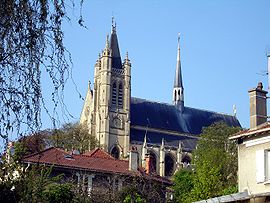- Montmorency, Val-d'Oise
-
For other places with the same name, see Montmorency (disambiguation).
Montmorency

St, Martin Collegiate Church 
Location (in red) within Paris inner and outer suburbs Administration Country France Region Île-de-France Department Val-d'Oise Arrondissement Sarcelles Canton Montmorency Intercommunality Vallée de Montmorency Mayor François Longchambon
(2001–2008)Statistics Land area1 5.37 km2 (2.07 sq mi) Population2 21,654 (2006) - Density 4,032 /km2 (10,440 /sq mi) INSEE/Postal code 95428/ 95160 1 French Land Register data, which excludes lakes, ponds, glaciers > 1 km² (0.386 sq mi or 247 acres) and river estuaries. 2 Population without double counting: residents of multiple communes (e.g., students and military personnel) only counted once. Coordinates: 48°59′26″N 2°19′22″E / 48.9906°N 2.3228°E
Montmorency (French pronunciation: [mɔ̃mɔʁɑ̃ˈsi]) is a commune in the northern suburbs of Paris, France. It is located 15.3 km (9.5 mi) from the center of Paris.
Montmorency was the fief of the Montmorency family, one of the oldest and most distinguished families of the French nobility. It is now a wealthy suburb of Paris.
Contents
Name
The name Montmorency was recorded for the first time in Medieval Latin as Mons Maurentiacus (attested in 993). Mons Maurentiacus, literally "Mount Maurentiacus", was the name given to the promontory over which a castle was built in the Early Middle Ages. Maurentiacus, the name of the area surrounding the promontory, meant "estate of Maurentius", probably a Gallo-Roman landowner.
In 1689 Montmorency was officially renamed Enghien (read history section below), but the village on the slopes of the promontory was still referred to as "Montmorency" by most people.
Indeed, during the French Revolution, at the creation of French communes in 1790, the newly born commune was named Montmorency. Three years later in 1793, at the peak of the French Revolution, the name of the commune, which was probably thought of as too reminiscent of the overthrown Ancien Régime, was changed into Émile, in honor of French philosopher and writer Jean-Jacques Rousseau who had composed his educational treaty Émile a few decades earlier while in residence at Montmorency.
In 1813 the commune was renamed Montmorency. In 1815, at the Restoration of monarchy, the commune was renamed Enghien. Throughout these troubled years, however, the village was always referred to as "Montmorency" by people, no matter the repeated official name changes.
The name "Enghien", on the other hand, was used for the lake and marshland in the valley beneath Montmorency, an area that was withdrawn from the jurisdiction of the commune of Montmorency/Enghien in 1790, and was divided between the jurisdictions of several neighboring communes. In other words, the place called "Enghien" was not located within the commune of Enghien.
This confusing situation was ended on 27 November 1832 when the commune of Enghien was definitely renamed Montmorency. Eighteen years later in 1850 the area of Enghien, which had developed as a spa resort, was incorporated as a commune (named Enghien-les-Bains) by detaching its territory from the territory of four communes neighboring Montmorency. The commune of Montmorency did not lose territory, and as such was not concerned by the incorporation of the commune of Enghien-les-Bains.
History
Montmorency was the fief of the Montmorency family, one of the oldest and most distinguished families of the French nobility, who owed their name to the location of their ancestral castle on the promontory of Montmorency. The castle of Montmorency was destroyed by the English during the Hundred Years' War and was not rebuilt. After the Hundred Years' War, the Montmorency moved their residence to the Château d'Écouen in Écouen, 5.6 km (3.5 mi) to the northeast of Montmorency.
In 1632 the last Montmorency, Henri II de Montmorency, was executed for treason in Toulouse and the duchy of Montmorency was inherited by the Princes of Condé, a cadet branch of the French royal family who, like the Montmorency, did not reside in Montmorency, choosing instead the Château de Chantilly as their residence. In 1689 King Louis XIV allowed the duchy of Montmorency to be renamed duchy of Enghien, in memory of the duchy of Enghien (modern-day Belgium) which the Princes of Condé had lost in 1569 at the death of Louis I de Bourbon, Prince de Condé. Montmorency/Enghien was the fief of the Princes of Condé until the French Revolution.
Transport
Montmorency is served by no station of the Paris Métro, RER, or suburban rail network. The closest station to Montmorency is Enghien-les-Bains station on the Transilien Paris – Nord suburban rail line. This station is located in the neighboring commune of Enghien-les-Bains, 2.1 km (1.3 mi) from the town center of Montmorency.
Personalities
- Christian Nade,footballer
See also
References
External links
- Official website (French)
- Mérimée database - Cultural heritage (French)
- Land use (IAURIF) (English)
Categories:- Communes of Val-d'Oise
Wikimedia Foundation. 2010.


